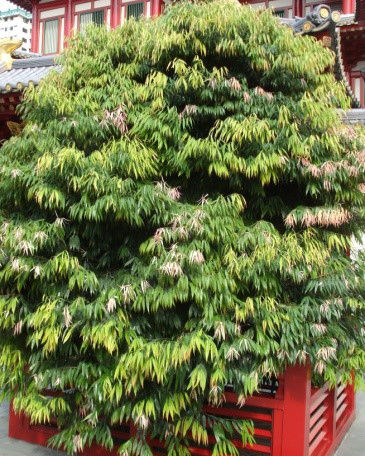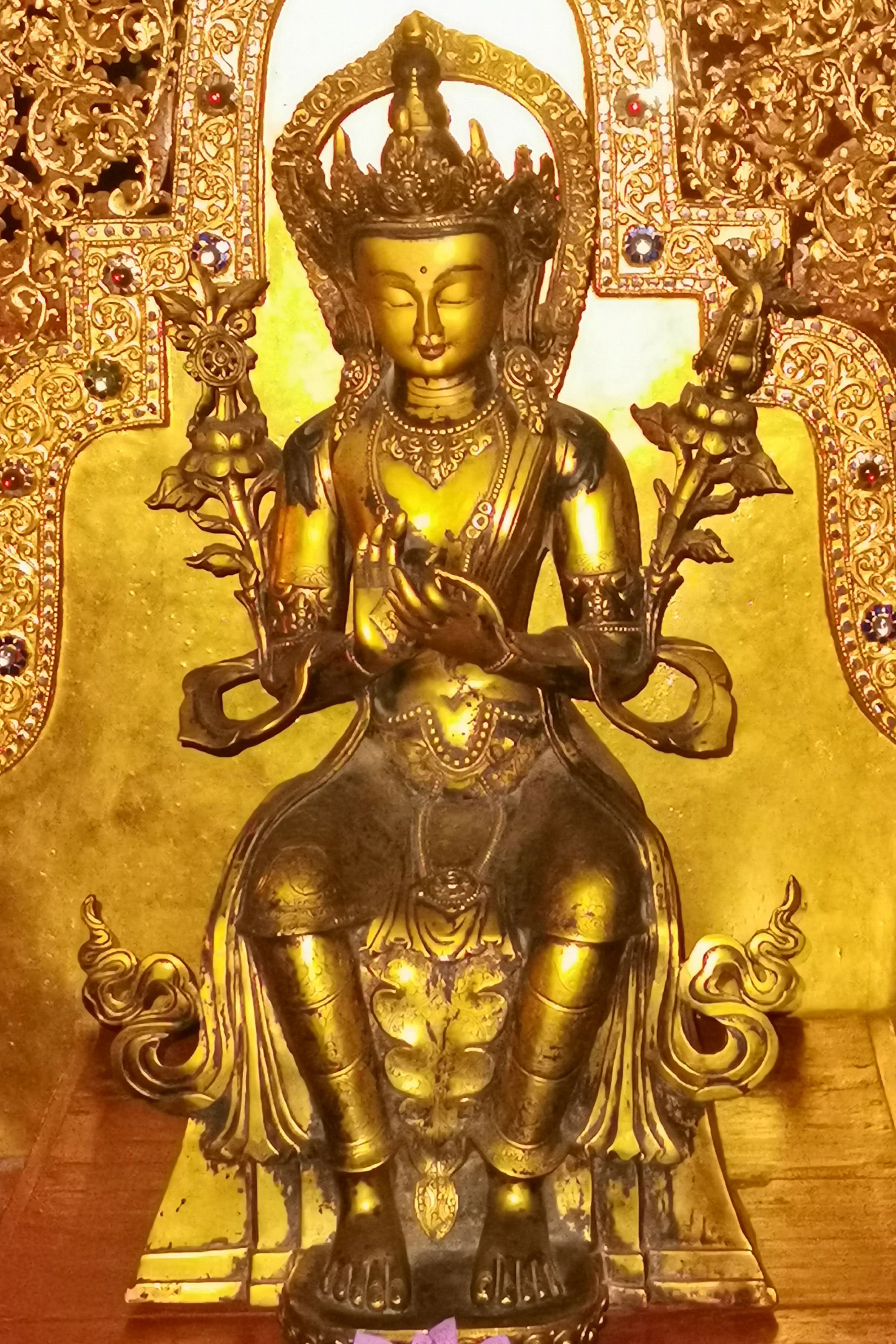First Storey
Mountain Gate Topics
First Storey Topics
Naga Trees
Have you noticed the four special trees in their red timber boxed-in fences in front of Buddha Tooth Relic Temple & Museum Mountain Gate? These trees have a close relationship with the Buddha Maitreya.
About Naga Trees
Nagapuspa Trees
These four special trees in front of the Temple are precious gifts from Venerable Galboda Sri Gnanissara Maha Thero of the Gangaramaya Monasteryin Colombo, Sri Lanka. They were root-balled from Sri Lanka and air lifted to Singapore to be planted in this very auspicious location.
Mesua ferrea (Ceylon ironwood, Ironwood tree, Indian rose chestnut, Cobra's saffron, Penaga lilin, Na [Sinhalese] or Nahar/Nahor) is a species in the family Clusiaceae. The plant is named after the heaviness of its timber and cultivated in tropical climates for its form, foliage, and fragrant flowers. It is native to tropical India, Sri Lanka, Cambodia, Malay Peninsula, Indonesia and also cultivated in Assam, southern Nepal, and Indochina.
About Form
It is a medium to tall evergreen tree reaching up to 100 ft tall, with a regular, conical, denseand dark green crown. It is a very slow growing tree, which is commonly seen in the wet zone, located at an altitude of 1,500 meters, in Sri Lanka.
About Leaves
It has narrow, oblong, lanceolate dark green leaves measuring 7-15 cm long, with a whitish grey underside; the emerging young leaves are red to yellowish pink and drooping The old leaves are dark green in colour.
About Flowers
The large flowers are 4-7.5 cm in diameter, with four white petals and in the middle, there are numerous yellow stamens. The flowers are very fragrant but their flowering is irregular.
About Fruits
The fruits are ovoid, conical and dark brown with one to four compressed seeds.
About Trunk
The trunk is often buttressed at the base, with a trunk up to two meters in diameter. The bark is grayish-reddish-brown, shallowly fissured and flaky.
About Uses
It is planted along roadsides for its attractive leaves.
The wood is very heavy, hard and strong. Its weight is about 72 lbs per cubic foot and its density is 1.12 kg/m3. Its colour is deep red. It is moderately refractory to sawing and machining. It is used in railroads, heavy timber structures, boat building, props in mines and tool handles etc.
Its resin is slightly poisonous, but its other parts have medicinal properties. It improves and enhances complexion as it revitalises transparency to the skin. The leaves are used to treat fever, sore eyes and leprosy. The flowers are acrid, anodyne, digestive, constipating, stomach ache. They are useful in conditions like asthma, leprosy, cough, fever, vomiting and impotency. The seed oil is considered to be very useful in conditions like vata and skin diseases. Dried flowers are used for bleeding haemorrhoids and dysentery with mucus. Fresh flowers are a useful remedy for itching, nausea, erysipelas, bleeding piles, metrorrhagia, menorrhagia, excessive thirst, and sweating. The fragrant stamens are used to stuff pillows and cushions for bridal beds. Oil from the seeds is used for sores, scabies, wounds, and rheumatism. The stamens and seed oil are used to help control excessive bleeding.
The seed oil is used for lubrication and manufacturing of soap.
About Dharma
Whilst the Buddha Sakyamuni attained Enlightenment under the Bodhi Tree, the Maitreya Bodhisattva will attain Enlightenment under the Nagapuspa (Nagakesara) Tree. He will then go to Mount Grdhrakuta and hold the “Three Assemblies of the Nagapuspa” and leads hundreds of millions of human beings to Salvation. (Note: For more information about Buddha Maitreya, please see the web section: The Temple/First Storey/Hundred Dragons Hall/Maitreya Trinity)
According to the Maitreyavyakarana Sutra, The Prophecy of Maitreya, A Translation by Bhikkhu Kumarajiva, Mile chengfo jing (《彌勒成佛經》):
“A Dragon (Naga) tree will then be the tree under which he will win enlightenment; its branches rise up to fifty leagues, and its foliage spreads far and wide over six Kos. Underneath it Maitreya, the best of men, will attain enlightenment - there can be no doubt on that. And he will win his enlightenment the very same day that he has gone forth into the homeless life.”
The Naga tree is also described in the Anagatavamsa, The Chronicle of the Future Buddha, Bhikkhu Ashin Kassapa, verses 99 - 103:
99 The Naga tree will be the awakening (place) for that Blessed One.
100 Its trunk will be two thousand cubits. It will have 20,000 branches with curved tips (always) moving. It will shine like the outspread tail of a peacock.
101 The tips (of the branches) will be continually in flower and fragrant with a heavenly smell. The blossoms will be the size of wheels, with enough pollen to fill a nali measure.
102 (The tree) will send its perfume in all directions for ten leagues, both with and against the wind. It will scatter its flowers all around the throne of awakening.
103 People from the country, coming together there, will smell the excellent odour and pour forth words (of admiration), rejoicing in its odour.
About Art
Many Buddha Maitreya images show Him with the Nagapuspa flower and a water vase.
About Nagas
Nāga (Sanskrit: नाग, IAST: nāgá, IPA: [nəɡá], Javanese: någå, Khmer: នាគ neak, Thai: นาค nak, Chinese: 那伽, Tibetan: ཀླུ་, Bengali: নাগ) is the Sanskrit and Pāli word for a deity or class of entity or being, taking the form of a very great snake—specifically the King Cobra, found in Hinduism and Buddhism. The use of the term nāga is often ambiguous, as the word may also refer, in similar contexts, to one of several human tribes known as or nicknamed "Nāgas"; to elephants; and to ordinary snakes, particularly the King Cobra and the Indian Cobra, the latter of which is still called nāg in Hindi and other languages of India. A female nāga is a nāgī or nāginī.
Traditions about nāgas are also very common in all the Buddhist countries of Asia. In many countries, the nāga concept has been merged with local traditions of great and wise serpents or dragons. In Tibet, the nāga is equated with the klu, that dwells in lakes such as the holy Lake Manosarovar (Mapam Yumco) or underground streams and it guards over treasures. Usually depicted as having a human upper body and a serpent lower body with multiple snakes forming an auerole behind their heads, they are considered as beings of the animal realm, albeit with higher intelligence and limited supernatural powers. They are also credited to have safeguarded the Prajnaparamita Sutras when these—the principal Mahayana teachings—disappeared from this world shortly after Buddha passed away. In China, the nāga was equated with the lóng or Chinese dragon.
The Buddhist nāga generally has the form of a great cobra-like snake, usually with a single head but sometimes with many. At least some of the nāgas are capable of using magic powers to transform themselves into a human semblance. In Buddhist painting, the nāga is sometimes portrayed as a human being with a snake or dragon extending over his head. One nāga, in human form, attempted to become a monk but he was told by others that such ordination was impossible. With Buddha's guidance, it was reborn a man fulfilling his wish to become a monk.
In the 'Devadatta' chapter of the Lotus Sutra, an eight year old female Naga, after listening to Manjushri preach the Lotus Sutra, transforms her body into that of a male human and immediately reaches full enlightenment. This narrative reinforces the ironic viewpoint prevalent in Mahayana scriptures that a male human body is required for Buddhahood. If a being is so advanced in her realization, she can magically transform her body at will and demonstrate the emptiness of the physical form.
Nāgas are believed to both live on Mount Sumeru, among the other minor deities, and in various parts of the human-inhabited earth. Some of them are water-dwellers, living in streams or the mer; others are earth-dwellers, living in underground caverns.
The nāgas are the servants of Virūpākṣa (Pāli: Virūpakkha), one of the Four Heavenly Kings who guards the western direction. They act as a guard upon Mount Sumeru, protecting the devas of Trāyastriṃśa from attack by the Asuras.
Mucalinda, Muchalinda or Mucilinda is the name of a naga (a snake-like being), who protected the Buddha from the elements after his enlightenment. It is said that four weeks after Śākyamuni Buddha began meditating under the Bodhi tree, the heavens darkened for seven days, and a prodigious rain descended. However, the mighty king of serpents, Mucalinda, came from beneath the earth and protected with his hood the one who is the source of all protection. When the great storm had cleared, the serpent king assumed his human form, bowed before the Buddha, and returned in joy to his palace.
A depiction of this event can be found in our museum artefact titled 'Naga-protected Buddha'. Donated to Buddha Tooth Relic Temple & Museum by the late Justice Karthigesu, this statue shows Buddha sitting in a relaxed posture (lalitasana) on top of the body of Mucalinda with His right hand in the fear-dispelling mudra (abhaya mudra) and His left in meditative equipoise (dhyana mudra). The five-headed naga forms a canopy to shelter the Buddha from rain. This portrayal deviates from other more conventional representations of Naga-protected Buddha where He is usually shown seated in full lotus posture (vajrasana) with both hands in the dhyana mudra.
About Development of Buddha Tooth Relic Temple & Museum Naga Trees
The four Naga trees in Buddha Tooth Relic Temple & Museum were air freighted from Sri Lanka to Singapore and planted at their current site after their arrival on the evening of 11 April 2007. A special tree blessing ceremony was held on 12 April 2007.
Bibliography:
- Maitreyavyakarana Sutra: The Prophecy of Maitreya, A Translation by Bhikkhu Kumarajiva, Mile chengfo jing (《彌勒成佛經》)
- The Prophecy Concerning Maitreya ('Maitreyavyakarana')
- Translation @ by Edward Conze, in his Buddhist Scriptures (Penguin Books, 1959),
- Anagatavamsa, The Chronicle of the Future Buddha, Bhikkhu Ashin Kassapa, verses 99 - 103
- The Coming Buddha Ariya Metteyya, Buddhist Publication Society, Wheel Publication, 1992, ISBN 955-24-0098-8, pages 36 – 37
- Anagatavamsa Desana: The Sermon of the Chronicle-To-Be, John Clifford Holt, 1993, ISBN 13-978-81-208-1133-1/9788120811331
- The Future Buddha Maitreya – An Iconological Study, Inchang Kim, D. K. Printworld (P) Ltd., 1997, ISBN 81-246-0082-1, pages 23, 29
- Maitreya Buddha in Literature, History and Art, Asha Das, Punthi Pushak, 2003, ISBN 81-86791-38-8, page 23
- Trees of Our Garden City, A Guide to the Common Trees of Singapore, (Second Edition) National Parks Board, 2009, ISBN 978-981-08-3714-3, pages 134 - 135
Websites:
- http://en.wikipedia.org/wiki/Maitreya
- http://www.buddhanet.net/e-learning/history/maitreya-txt.ht
- http://en.wikipedia.org/wiki/Mesua_ferrea
- http://www.britannica.com/EBchecked/topic/103965/Ceylon-ironwood
- http://florafaunaweb.nparks.gov.sg/Special-Pages/plant-detail.aspx?id=3023
- Nāga - Wikipedia, the free encyclopedia
- Mucalinda - Wikipedia, the free encyclopedia








